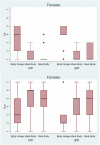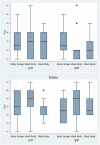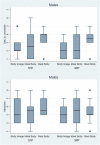Which Body Would You Like to Have? The Impact of Embodied Perspective on Body Perception and Body Evaluation in Immersive Virtual Reality
- PMID: 33501199
- PMCID: PMC7805750
- DOI: 10.3389/frobt.2020.00031
Which Body Would You Like to Have? The Impact of Embodied Perspective on Body Perception and Body Evaluation in Immersive Virtual Reality
Abstract
In this experiment, we aimed to measure the conscious internal representation of one's body appearance and allow the participants to compare this to their ideal body appearance and to their real body appearance. We created a virtual representation of the internal image participants had of their own body shape. We also created a virtual body corresponding to the internal representation they had of their ideal body shape, and we built another virtual body based on their real body measures. Participants saw the three different virtual bodies from an embodied first-person perspective and from a third-person perspective and had to evaluate the appearance of those virtual bodies. We observed that female participants evaluated their real body as more attractive when they saw it from a third-person perspective, and that their level of body dissatisfaction was lower after the experimental procedure. We believe that third-person perspective allowed female participants to perceive their real body shape without applying the negative prior beliefs usually associated to the "self", and that this resulted in a more positive evaluation of their body shape. We speculate that this method could be applied with patients suffering from eating disorders, by making their body perception more realistic and therefore improve their body satisfaction.
Keywords: body evaluation; body image; body perception; body satisfaction; eating disorders; immersive virtual reality; visual perspective.
Copyright © 2020 Neyret, Bellido Rivas, Navarro and Slater.
Figures















Similar articles
-
Embodying Others in Immersive Virtual Reality: Electro-Cortical Signatures of Monitoring the Errors in the Actions of an Avatar Seen from a First-Person Perspective.J Neurosci. 2016 Jan 13;36(2):268-79. doi: 10.1523/JNEUROSCI.0494-15.2016. J Neurosci. 2016. PMID: 26758821 Free PMC article.
-
Influence of Being Embodied in an Obese Virtual Body on Shopping Behavior and Products Perception in VR.Front Robot AI. 2018 Oct 3;5:113. doi: 10.3389/frobt.2018.00113. eCollection 2018. Front Robot AI. 2018. PMID: 33500992 Free PMC article.
-
Seeing an Embodied Virtual Hand is Analgesic Contingent on Colocation.J Pain. 2017 Jun;18(6):645-655. doi: 10.1016/j.jpain.2017.01.003. Epub 2017 Jan 18. J Pain. 2017. PMID: 28108385
-
The Use of Virtual Reality in Patients with Eating Disorders: Systematic Review.J Med Internet Res. 2018 Apr 27;20(4):e157. doi: 10.2196/jmir.7898. J Med Internet Res. 2018. PMID: 29703715 Free PMC article.
-
Real, rubber or virtual: The vision of "one's own" body as a means for pain modulation. A narrative review.Conscious Cogn. 2016 Jul;43:143-51. doi: 10.1016/j.concog.2016.06.005. Epub 2016 Jun 10. Conscious Cogn. 2016. PMID: 27295559 Review.
Cited by
-
Can virtual reality replace conventional vestibular rehabilitation tools in multisensory balance exercises for vestibular disorders? A non-inferiority study.J Neuroeng Rehabil. 2025 Apr 19;22(1):86. doi: 10.1186/s12984-025-01623-x. J Neuroeng Rehabil. 2025. PMID: 40253374 Free PMC article. Clinical Trial.
-
Use of a real-life practical context changes the relationship between implicit body representations and real body measurements.Sci Rep. 2021 Jul 14;11(1):14451. doi: 10.1038/s41598-021-93865-7. Sci Rep. 2021. PMID: 34262115 Free PMC article.
-
Anorexia Nervosa, Body Image Perception and Virtual Reality Therapeutic Applications: State of the Art and Operational Proposal.Int J Environ Res Public Health. 2022 Feb 22;19(5):2533. doi: 10.3390/ijerph19052533. Int J Environ Res Public Health. 2022. PMID: 35270226 Free PMC article.
-
Perception of Cosmetic Procedures among Middle Eastern Youth.J Clin Aesthet Dermatol. 2021 Dec;14(12):E74-E83. J Clin Aesthet Dermatol. 2021. PMID: 35096259 Free PMC article.
-
Repeated Exposure to Illusory Sense of Body Ownership and Agency Over a Moving Virtual Body Improves Executive Functioning and Increases Prefrontal Cortex Activity in the Elderly.Front Hum Neurosci. 2021 May 31;15:674326. doi: 10.3389/fnhum.2021.674326. eCollection 2021. Front Hum Neurosci. 2021. PMID: 34135743 Free PMC article.
References
-
- Bermúdez J. L., Marcel A. J., Eilan N. (Eds.). (1995). The Body and the Self. Washington, DC: The MIT Press.
LinkOut - more resources
Full Text Sources

